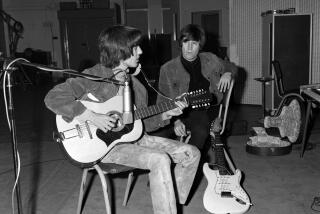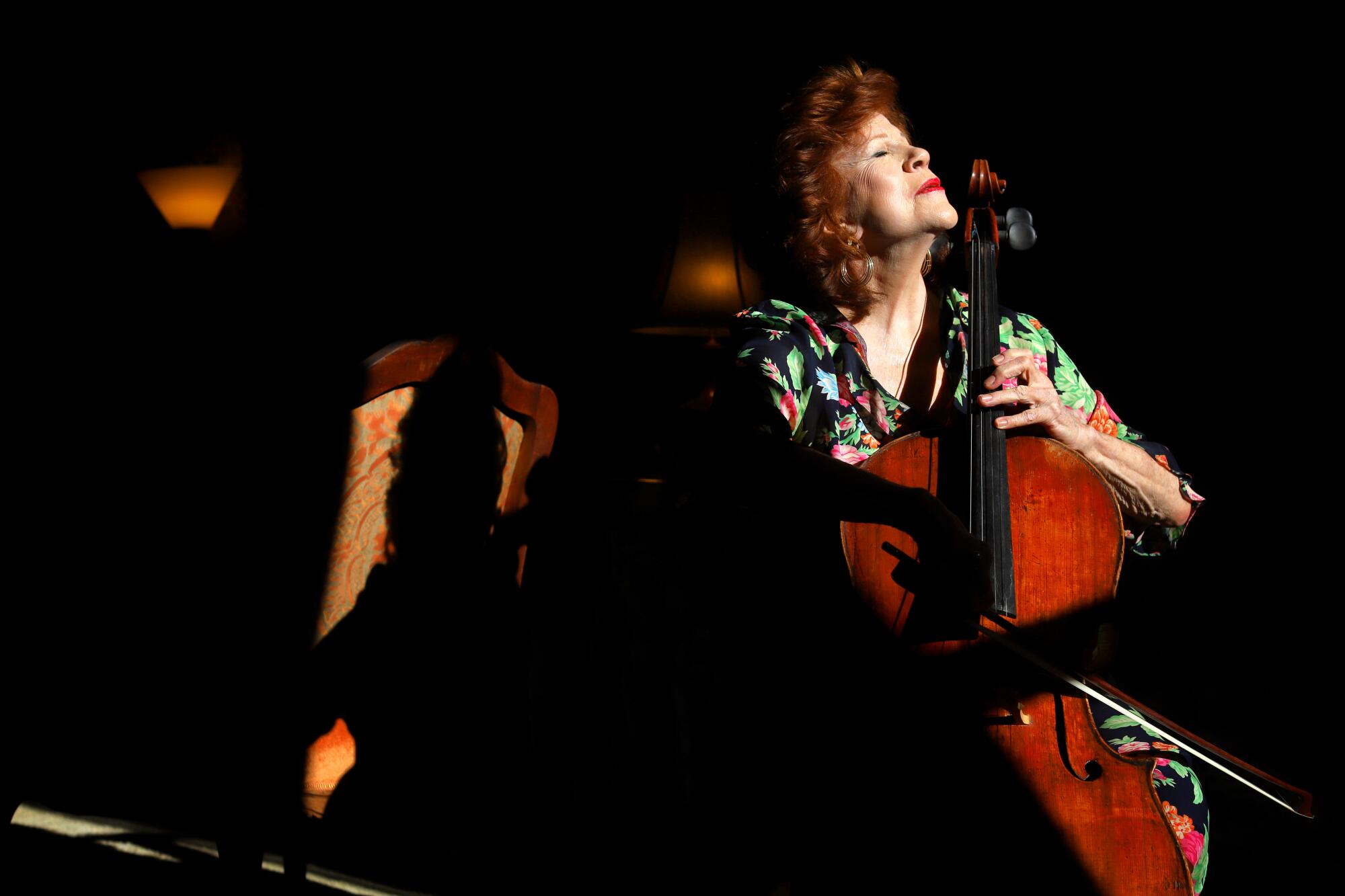
- Share via
NEW YORK — It was Sept. 14, 2013, when a mysterious email bearing the subject line “Is this your first cello?” landed in Christine Walevska’s inbox.
The renowned cello virtuoso, however, checked her emails infrequently. Walevska prefers more personal contact.
Decades spent touring the world had taught her that you could really take the full measure of someone’s intentions only by speaking with them — also, she didn’t like to type.
And so six months passed before she clicked on the missive sent by strangers living in Chico, Calif.
“Maybe you will recognize this cello,” the note read, describing the instrument made by the 19th century French luthier Auguste Sébastien-Philippe Bernardel. Three photographs were attached.
Walevska scanned the first two, showing the front and back of the instrument. When she pulled up the third, her heart nearly leaped from her chest. “I was so shaken up,” she recalled.
- Share via
The image revealed the luthier’s label, visible through one of the curlicued f-holes.
Across it was a note inscribed in the feathery pen of the master himself: Pour la petite Comtesse Marie 1834. “For the little Countess Marie.”
“I could hardly believe it,” she recalled. The cello had been given to her as a child by her father; nearly 40 years earlier, it had been stolen.
Custom-made for the daughter of a French aristocrat two centuries ago, it was a spectacular, rare one-eighth-size cello produced by Bernardel, protégé of Nicolas Lupot, violin maker to King Louis XVIII. Bernardel’s craftsmanship earned him renown as among the finest string instrument makers in France.
- Share via
“Can you imagine?” she gasped in disbelief. “My precious little Bernardel had surfaced after all these years!”
More than just her first cello, “it was my first love!” And she had grieved its loss as one does; she never forgot it.
Walevska responded to the email with alacrity: “Please phone me as soon as you can! Anxiously awaiting your phone contact.”
From that first moment, I wanted to be a great cellist
— Christine Walevska
Walevska had originally set her sights on the violin. At 7, she studied with her mother, Marion, a conductor and music teacher, but she chafed under her “overbearing” tutelage.
“I just couldn’t take it,” she recalled. “She was correcting me all the time.” Frustrated, Walevska tore up her sheet music. “And so that was the end of the violin.”
A year later, a French dealer offered the Bernardel to her father, Hermann Walecki, an internationally respected dealer of fine and rare classical instruments in Los Angeles. He presented the little cello to her in 1953. She was 8½.
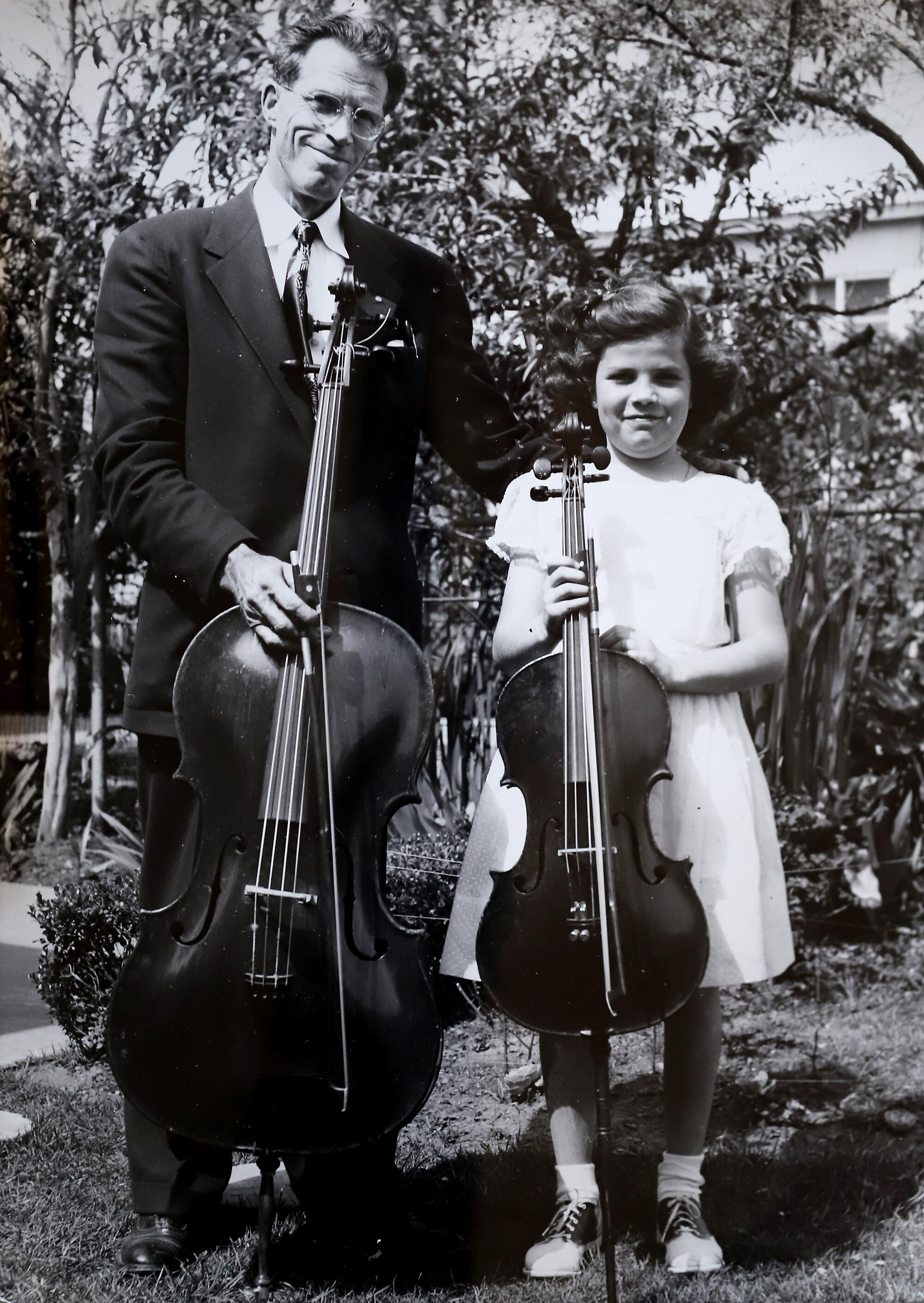
“I kissed it,” she recounted from the living room of her Manhattan apartment overlooking Central Park. On a wall hangs an oil portrait of her as a young girl playing the Bernardel. “From that first moment, I wanted to be a great cellist. My parents never had to ask me to practice.”
Her first teacher was her father, and she took to the instrument quickly. In a week she learned the jaunty Bourrée from Bach’s Cello Suite No. 3; soon she had developed her own little vibrato.
Gregor Piatigorsky, the great Russian American cellist, would later tell her: “The concerts you are playing at age 18 are the ones I did not play until I was in my 50s.”
Walevska is lean and elegant with expressive hands. A tempest of enthusiasm, she can be disarmingly charming and startlingly blunt. Her thoughts open up like an accordion, expanding into tales of a life spent circling the globe with a cello case in one hand, a suitcase full of concert dresses in the other.
“It’s not easy going from place to place every three days,” she said. “Do you think all those people in the orchestras gave up their youth, as I gave up my youth?”
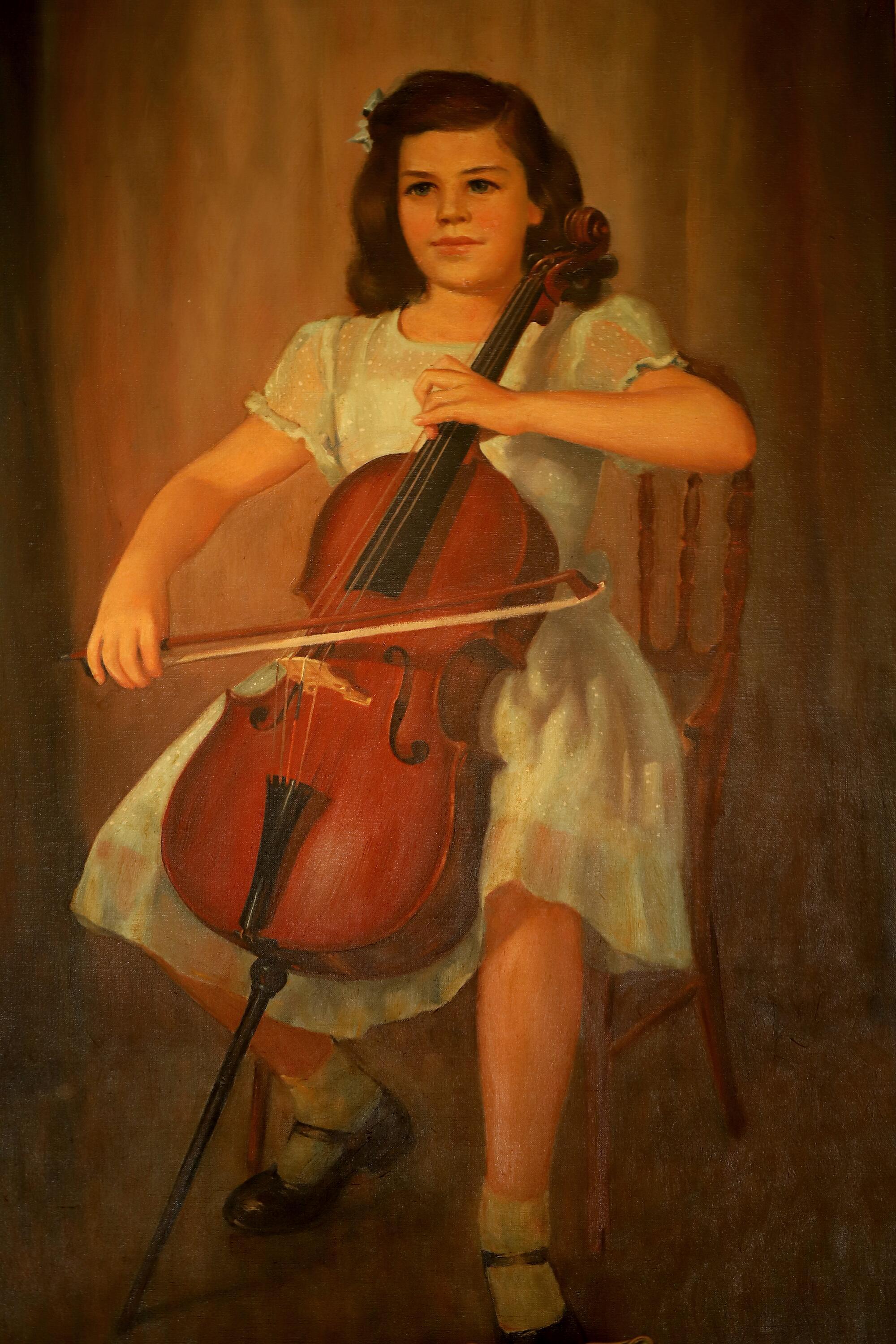
The earliest cellos date to the 16th century. They are soulful, vibrating instruments. The music swells and recedes on a tide of bow strokes. The Swiss American composer Ernest Bloch likened its sound to a human voice, “vaster and deeper than any spoken language.”
But it is also a large instrument. From the tip of the scroll to the bottom, a cello measures 4 feet long, obliging players to sit down and cradle it.
By necessity, a child learns to play on a scaled-down instrument. But few masters produced superbly crafted instruments for children. “It’s definitely a rare little cello,” said Christophe Landon, a violin maker and one of the world’s most famous dealers and appraisers. “There were many violins made in Mirecourt,” he explained, referring to the French center of stringed instruments in the 19th century. “But such a cello of that size? Almost never.”
“My father was a smart man,” Walevska said. “He knew that many of these children’s parents say, ‘Well, I’ll buy them a cheap instrument and if they do well, then I can buy a better instrument.’.... He realized the great value of a child falling in love with the sound of the instrument.”
Hermann, the son of a royal cabinetmaker from England, had opened Westwood Musical Instruments in 1947 and catered to its diverse and luminous population of professionals and students.
His arrival coincided with a golden age in classical music in Los Angeles. The Philharmonic was a showcase for important composers like Igor Stravinsky, while the booming film industry created an endless appetite for musicians and composers, many of whom had fled the Nazis, including Max Steiner, who wrote the score for “Casablanca” and “Now, Voyager.”
Hermann, she said with a note of pride, “sold more Stradivarius instruments in the last 10 years of his life than all of the dealers in the world put together.”
According to Walevska, his ledger included the Mendelssohn Stradivarius (known as the “Red Violin”) and the Lord Nelson Stradivarius, so named because it was found on the commander’s flagship during the Battle of Trafalgar.
The family’s home frequently played host to the city’s finest musicians. During these gatherings Walevska often performed on the Bernardel, leaving the professionals slack-jawed at her command of the instrument.
When Ennio Bolognini, the great Argentine cellist, and his wife heard Walevska play, she whispered in his ear, “This little girl is going to be a great cellist.” He whispered back, “She already is.”
Bolognini became her teacher. At 12, Walevska performed a haunting Saint-Saëns Concerto with the National Symphony. At 13 she studied with Piatigorsky. At 18, she became the first American to win the first prize in cello and chamber music at the Paris Conservatoire.
The pianist Arthur Rubinstein described her as having “the most sensuous tone I have ever heard on the cello. … She is the only cellist who takes my breath away.”
Still, she remained stubbornly attached to the Bernardel, said her brother Fred, recalling how hard-pressed she was to move up to a larger instrument. Hermann mounted the little cello on a wall in his store, telling her, “You will hand this down to your daughter, and her child after that.”
When Hermann died in 1967, Fred took over the music shop and transformed it into a rock ‘n’ roll mecca — the place where everyone from the Beach Boys to the Rolling Stones went to buy guitars and have them repaired.
Then one day in 1976, two men in their 30s walked into the store. “Wow, what a far-out store,” Fred remembered one of them saying. “You must have a lot of expensive things. What are the most valuable?”
Without thinking, Fred immediately pointed to his sister’s cello on the wall, as well as a custom-made guitar with mother-of-pearl inlay.
That night, after closing, the store’s windows were smashed, setting off the alarm. By the time the police arrived, the cello and the guitar were gone.
Walevska was living in New York City when her mother called her, sobbing. “I do remember vividly that I was standing in the dining room,” she said.
“Christine,” her mother said, “there’s been a terrible tragedy. The baby cello has been stolen.”
The family filed a report with the LAPD and blanketed the area’s dealers and pawnshops with fliers. Fred alerted important dealers in Los Angeles, San Francisco, Paris and Switzerland. The cello was one-of-a-kind and easily identifiable if someone tried to unload it to a reputable dealer.
But the weeks turned into months and then years. The Bernardel had vanished without a trace.
So profound was Walevska’s grief that her brother burned the wooden case that her father had custom-built and her mother had lovingly lined in green velvet. “It was a bad memory,” she said.
“My mother died in 1990 and she always prayed that this cello would be found,” she lamented. “I prayed to St. Anthony,” the patron saint of lost and stolen articles, “for years.”
I knew immediately, she was a big talent. ... This little girl’s name, Starla, is well chosen.
— Christine Walevska
In 2011, Dustin Breshears was a young piano teacher managing Chico’s youth orchestra, living with his wife, Julie, and their three young children. He always brought the kids to the orchestra’s weekly rehearsals, and two were drawn to the violin, Dustin Jr., then 4, and Valery, the youngest at 2.
But 3-year-old Starla gravitated to the cello. “I liked that it was big and it just sounded so much nicer than the squeaky violin,” she said, now 12. “I don’t remember asking my parents. I just wanted to play.”
All three were gifted. They stunned audiences when performing in local concerts and festivals. Dawn Harms, who sits on the music faculty at Stanford, called them “little adults in little genius bodies.”
Harms, who met them when she gave a master class for young students, found their talent dizzying. “They all had perfect pitch. They could memorize music instantly. Not only were they technically perfect, but they played with feeling,” said Harms, who began teaching them at the San Francisco Conservatory. “That is rare. They literally tell a story.”
Despite the family’s modest finances, when Starla turned 4, her parents began searching for a fine, antique one-eighth-size cello. The Breshearses refused to settle for a factory-made Chinese one. “Everybody just thought I was ridiculous,” Dustin recalled.
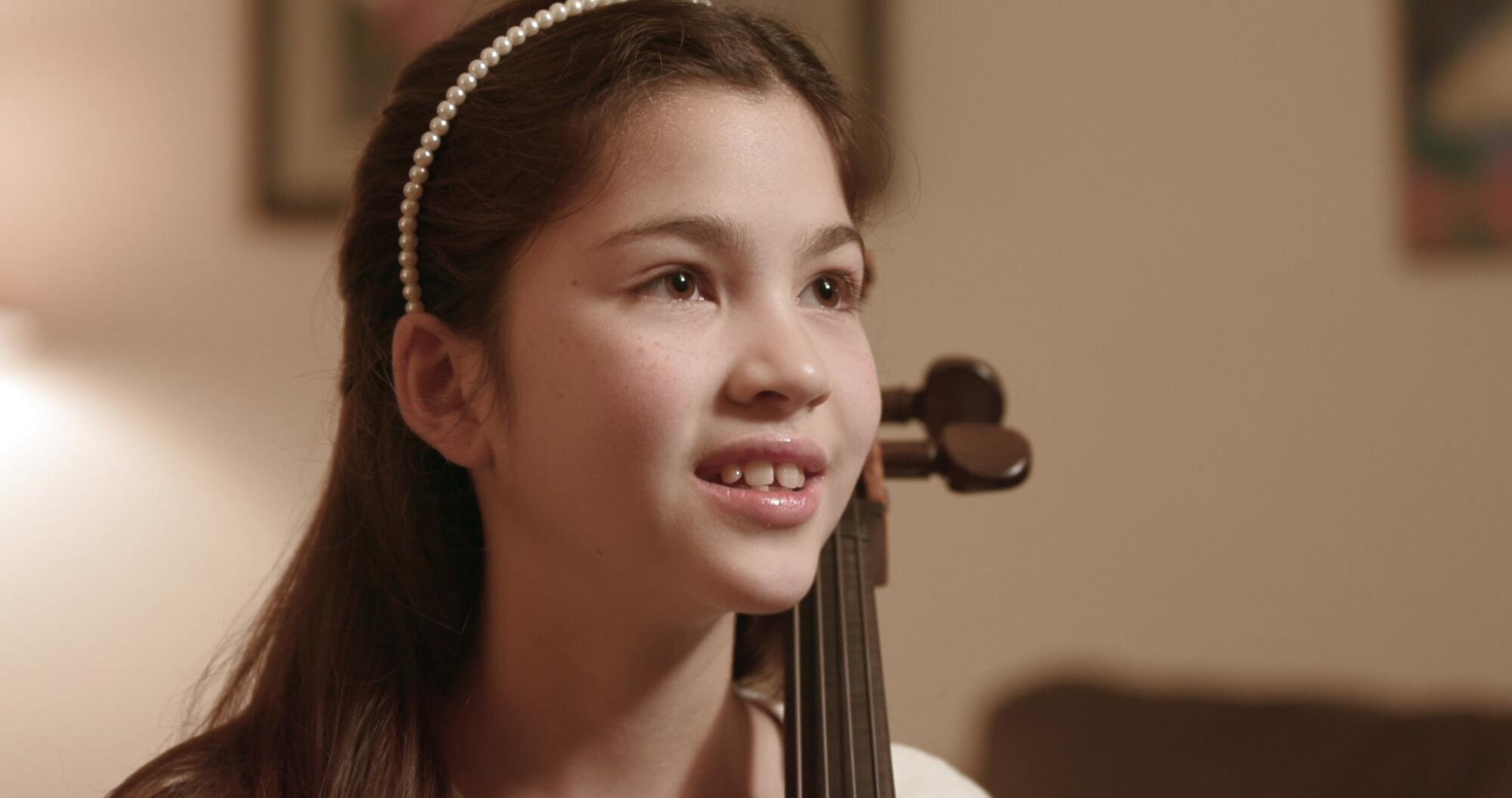
After a year of searching, Julie heard from a Los Angeles dealer named Georg Eittinger, who said he had just the instrument, but he wasn’t particularly keen to part with it. It was made in 1834 by the luthier Bernardel and, as far as he knew, hadn’t been played for at least 30 years.
According to Julie, he told them he would consider lending it out only if “there was a student of exceptional ability.” Eittinger, a master violin maker born and trained in Germany, said he needed to hear Starla play.
In 2004 Eittinger purchased Hans Weisshaar, the eponymous buyer, seller and restorer of fine stringed instruments. The shop, then on Larchmont Avenue, had opened in 1947, the same year that Hermann Walecki opened Westwood Musical Instruments. Eittinger had first worked under Weisshaar in the 1990s as a restorer.
The Breshearses packed up the family, which had by then expanded to five children (there would be six in all) and drove 12 hours through the night, arriving at the shop on the afternoon of Sept. 7, 2013.
Eittinger once again expressed his wariness; he didn’t even let his son, who played the cello, run a bow across the Bernardel.
Oblivious to the adults, Starla, wearing a pink party dress with a white ribbon in her hair, sat down in a folding chair and placed the tiny cello between her legs. It was nearly as big as her. For two hours she tore through her repertoire: Bach’s Cello Suite No. 1, concertos by Georg Goltermann and Jean-Baptiste Bréval.
Then as now, she didn’t look at sheet music or down at the strings as she played. The music flowed through her fingertips, drawn from some unseen spring inside of her.
“She was certainly outstanding, especially considering her age,” Eittinger recalled with Germanic exuberance. “We deal with customers who are highly professional and we see prodigies. Nonetheless, she was exceptional.”
They made an arrangement. The Breshears family would rent the instrument for $150 a month. Dustin took out a $30,000 insurance policy at Eittinger’s request. It was an exorbitant amount for the family. “But,” said Dustin, “I wanted Starla to have this cello.”
Starla fell in love with the little Bernardel immediately. “It felt like a part of me,” she said.
Julie found the label intriguing. “I thought it was crazy that this belonged to a countess and nobody knows about it.” So she searched the internet looking for clues. When she typed in “Bernardel” and “Pour la petite Comtesse Marie 1834” she came across an interview that Christine Walevska had done with the Internet Cello Society.
The Breshearses decided to reach out to her. They typed up an email, attached three photos and waited.
It was shortly after Walevska’s birthday, March 8, 2014, when she spoke to the Breshearses.
The conversation started on a note of wariness but quickly turned to amazement. The Breshearses described how Starla had been winning contests and was about to solo with an orchestra. Walevska recounted the instrument’s theft. “Now you know the true story of that instrument,” she told them.
The Breshearses were dumbstruck.
Walevska bristled when they told her that the Bernardel came from the Hans Weisshaar shop. Mr. Weisshaar, she remembered, was a not-so-friendly competitor of her father’s.
Before they ended the phone call, Dustin told her, “You should have your cello back.”
“We’ve got to figure out how to handle this properly,” she replied.
The Breshearses sent Walevska videos of Starla playing the cello, and as she watched Starla perform, Walevska saw herself. “I knew immediately, she was a big talent,” she said. “This little girl’s name, Starla, is well chosen.”
She came to believe the twists of fate had played an ingenious hand. “I mean look at this, two Californians; this little girl is starting out with the same cello that I began this lifelong love of the instrument and a lifelong career.”
It didn’t take long for Walevska to come to a decision. She told the Breshearses that Starla should continue to play the Bernardel until she was ready to move on to a larger instrument. Once that day came, she would contact the police. Until then, she cautioned everyone to keep its existence to themselves.
I had to reconstruct a crime that occurred 40 years ago when nothing from the original crime exists anymore.
— Det. Don Hrycyk
As 2015 drew to a close, it was time. Dustin Breshears informed Walevska that Starla was ready to move up to a one-quarter-size cello.
While still in New York, she dispatched her nephew to visit the LAPD’s West L.A. Division to get the ball rolling. That’s where the problems began.
A detective and other LAPD staffers tried to track down the original police report from 1976, but none was found.
Undeterred, Walevska embarked on a letter-writing campaign, blanketing the LAPD, including then-Chief Charlie Beck. On Feb. 18, 2016, he responded, cautioning her that this would be tough sledding: “Your case has legal hurdles that first must be overcome.”
Walevska needed to show that the cello was indeed the same instrument stolen from Westwood Musical Instruments. Secondly, she had to prove she was its legal owner. Beck informed her that he had assigned Det. Don Hrycyk, who ran the art theft detail, to the case.
Hrycyk, who had once worked homicide in South Los Angeles’ 77th Street Division, had emerged as the country’s only metropolitan cop dedicated to art crimes.
Over the course of his career, Hrycyk (pronounced her-ris-sik) had successfully hunted down stolen Picassos, Nicolas Cage’s rare 1938 edition of “Action Comics No. 1,” the Scarecrow’s tap shoes from “The Wizard of Oz” and O.J. Simpson’s Heisman Trophy.
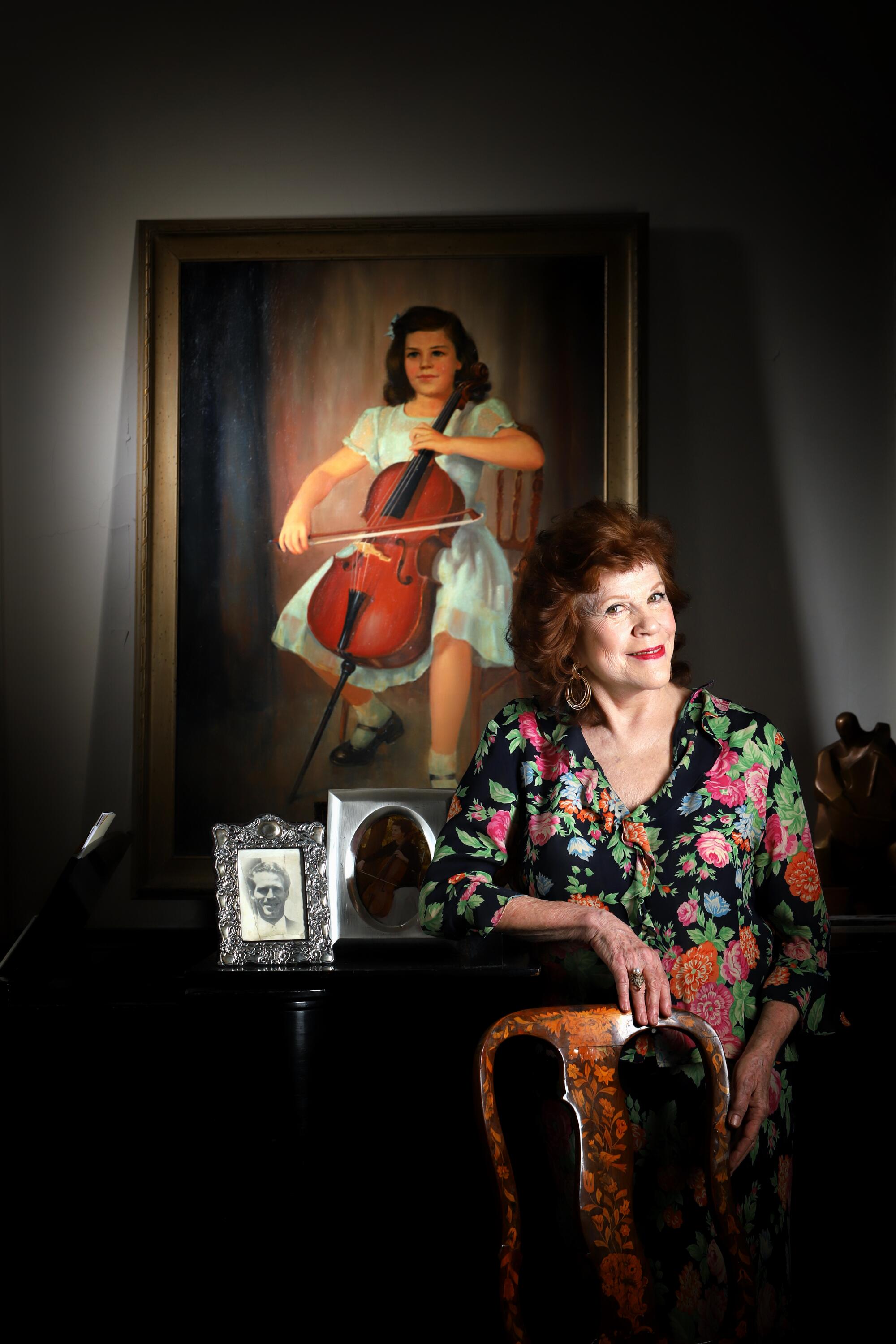
But Hrycyk had also proved proficient in the niche specialty of rare instruments, having spearheaded the recovery of several, including multiple Stradivariuses. In 2004 he helped repossess the $3.5-million General Kyd Stradivarius cello on loan from the L.A. Philharmonic to cellist Peter Stumpf after it had been filched from the front porch of his Los Feliz home.
Three years later, his handiwork helped with the return of an 18th century Tononi violin and bow and an 1855 Vuillaume violin valued at nearly $300,000 that turned up in Paris. He’d been aided by highly detailed photographs of the missing instruments.
“With good quality photos of the instrument showing the actual grain of wood, it can almost be used to ID an instrument like a fingerprint,” Hrycyk explained. “I’ve had a lot of luck in recovering musical instruments.”
However, he called the theft of the Bernardel, “a nightmare.”
“I had to reconstruct a crime that occurred 40 years ago when nothing from the original crime exists anymore,” said Hrycyk, who often salts his conversation with old-timey phrases like “he’s into skullduggery” or “they were hoodwinked.”
In the case of the Bernardel, there was no documentation and no police report, just Walevska’s word, and the mountain of photographs and testimonials she supplied.
Walevska however, was determined to get her little Bernardel back. She also thought it was more than strange that her cello was found in the store that had been owned by her father’s competitor.
In her letter to the LAPD, she pointed out the unusual coincidence, underscoring the men’s rivalry, with a few choice words.
Weisshaar died in 1991. He gave his stock in the company to his protégé Margaret Shipman, who had met Weisshaar in 1968 when she was doing graduate work at USC and she brought her cello in for repairs. Soon she was working there on Saturdays.
She recalls seeing the cello there displayed with other rare and unusual pieces. “It was a unique enough cello, hard to not notice it,” she said. “The first time I saw it, I remembered thinking, ‘What maker would go to that trouble for a children’s cello’? Then I saw the label and thought, ‘Oh, it was made for royalty.’”
Although Shipman knew of Westwood Musical Instruments, she said she had no idea that the Bernardel was stolen until Hrycyk contacted her. More to the point, of Weisshaar she said, “I don’t think he’d keep anything that was stolen.”
Eittinger, who acquired the business from Shipman in 2004, was equally shocked when Hrycyk informed him the Bernardel was stolen. “I got a visit from the detective,” he said. “I didn’t know the history of the instrument. The only thing I know is that it was in the shop in the early ’90s and it was part of the inventory when I purchased the shop.”
Hrycyk spent six months attempting to reconstruct what happened. It was a little like trailing a ghost.
Hrycyk didn’t think there was a whole lot of chicanery or subterfuge involved with the Bernardel. “A lot of times the burglar, they don’t really have a receiver for the type of property taken. They get rid of what they can and then get stuck with the musical instruments.” In other words, the cello might have traded hands multiple times before it wound up with Weisshaar.
The detective also didn’t put a lot of stock in Walevska’s theory that her father‘s and Weisshaar’s rivalry might have played a part. “I think that if he had any crooked intentions he wouldn’t have prominently displayed it at his violin shop,” he said.
Still, Hrycyk was fairly certain the Bernardel belonged to Walevska, even if under the law he couldn’t prove it.
But he was sympathetic. “She’s a very emotional woman,” he said. “Lots of artists are, and so she was very dogged in her pursuit in getting this back; she firmly believed this was her cello. Unlike many people, she didn’t give up.”
He suggested she make the case to Eittinger herself, in person.
By then it was the summer of 2016. Walevska was invited to perform in Poland, but she switched course. “I can’t let anything interfere with this matter before me,” she vowed. “I have to succeed in getting my cello back.”
When you go onstage, you have to have control over any stress or nervousness that you have, in order to play marvelously well.
— Christine Walevska
Walevska had arranged with the Breshearses to arrive at the shop right after they returned the Bernardel in August of that year. It would also be their first meeting in person.
She wasn’t sure what to expect.
Walevska, however, was certain of two things. First, she was going to succeed. Second, her life performing onstage had prepared her for this moment.
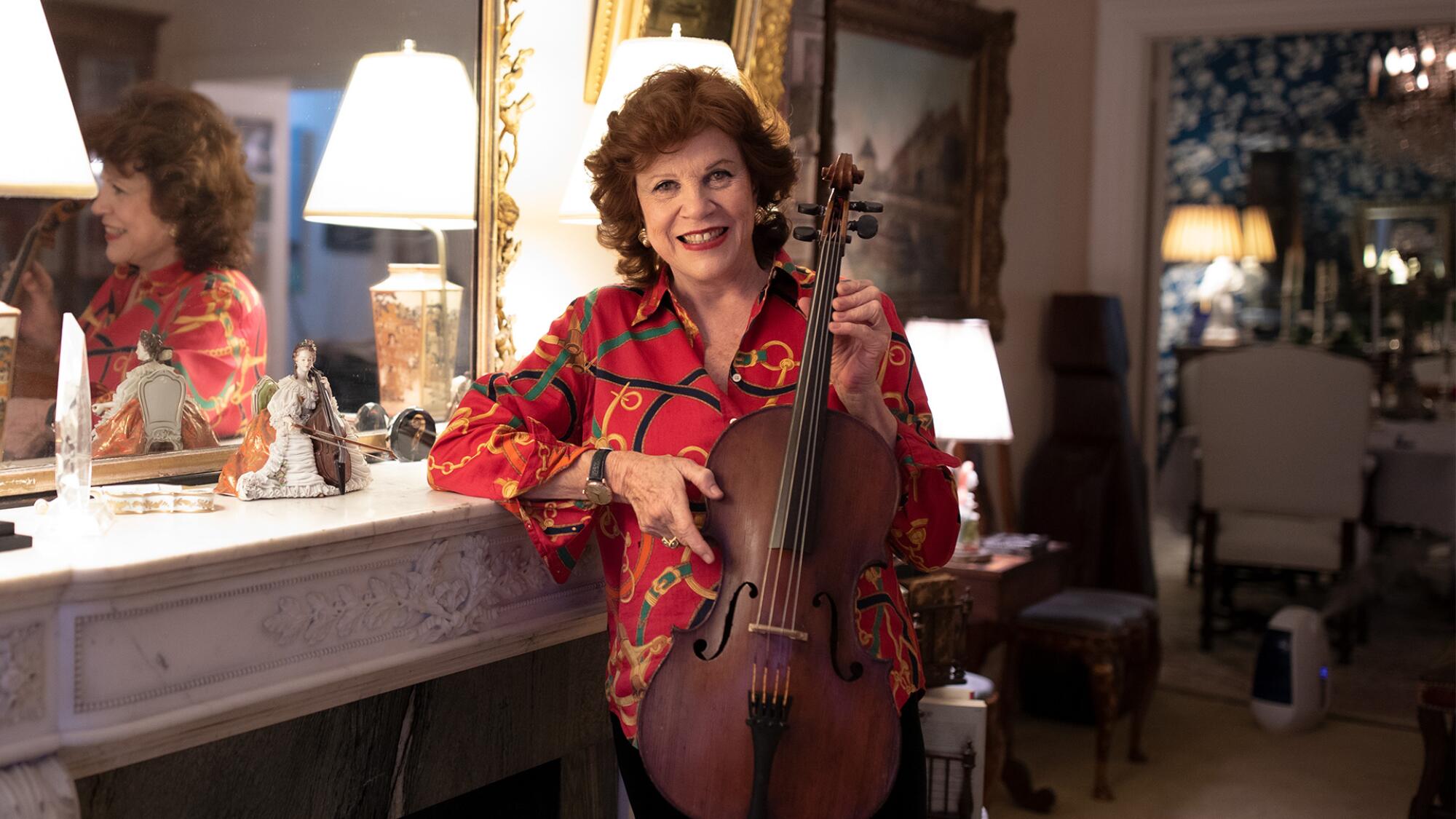
“I kept my wits about me,” she said. “When you go onstage, you have to have control over any stress or nervousness that you have, in order to play marvelously well. You cannot give in to your feelings. You have to have strength.”
Fairly quickly, Walevska sized up that Eittinger knew nothing about the theft. “He was presented with all of this information, which was a shock to him.” Then she made her appeal: “I said, ‘You know, this can be a win-win situation for you because it speaks highly of you to cooperate and to return the cello to its rightful owner.’”
Understandably, he didn’t want any legal or financial exposure. The two had a private conversation and, within days, she provided more documents at his request and to his satisfaction. They took a photograph of the two of them and the cello. “I gave him a kiss on the cheek,” she said.
Dustin recalled seeing Walevska with the Bernardel. “I thought she might cry, but she didn’t get emotional, it was like they’d never been apart.”
Walevska spent a week in Los Angeles with the Breshearses at the home of Ayke Agus, the former piano accompanist for Jascha Heifetz.
When she met Starla for the first time, Walevska hugged her and called her “my little star.” She now referred to the cello as “our little Bernardel.”
She doesn’t let me give up.
— Starla Breshears, on mentor Christine Walevska
As happy endings go, this might suitably have ended right there. But in many ways this is where the story begins. Walevska got her cello and a protégé; Starla got a mentor and a friend.

Her gratitude boundless, Walevska vowed to the Breshearses, “I will do anything for the rest of my life to help your daughter in any way I can.”
The two talk on the phone and conduct semi-regular lessons on Skype. Starla said that Walevska was more than just a teacher. Pausing carefully to articulate her feelings, she then offered, “She is my support. She’s always there for me. If like, I’m having a difficult time on the passage, she’ll say, ‘Just let it go. And you can come back to it,’ and I do,” Starla said. “And then if it doesn’t work she just says, ‘You have to keep trying.’ And it eventually works. She doesn’t let me give up.”
During a school assignment in which the students were asked to name their hero, Starla chose Walevska. “She is an amazing cellist,” and “she taught me to interpret pieces like none other.”
Walevska gave Starla a boxed set of her recordings, and she likes to play along to them.
A year after their initial meeting, Walevska flew from New York to Chico and gave a master class and a concert. She also attended a concert at the San Francisco Conservatory, where Starla performed with her brother Dustin and sister Valery. They traveled together to Los Angeles, where the children played a concert, and spent another week giving her lessons. “This has been an inspiring experience to know this family,” Walevska said.
Dustin described the lessons as amazing. “She learned with Piatigorsky and all of these famous old-school teachers. All these great artists of the past were being passed down to Christine and then to Starla.”
Walevska estimates that there have been five great female cellists. “My belief is that this little girl could be in line to be the sixth.”
Starla says her dream is to play a duet with Walevska, but she hasn’t mustered up the courage yet to ask her.
Recently, Walevska reflected on this most unimaginable turn of events. “I mean, this is a little bit of an interesting twist on stolen instruments, right? There were so many variables that could have happened. I describe it as being grace from God. From this awful situation has developed a great relationship.”
Walevska had always viewed the theft like a death, but she has had a change of heart. Fate had put her precious Bernardel into the talented hands of another little girl, and now she and a 186-year-old cello were given new life.
More to Read
Inside the business of entertainment
The Wide Shot brings you news, analysis and insights on everything from streaming wars to production — and what it all means for the future.
You may occasionally receive promotional content from the Los Angeles Times.




